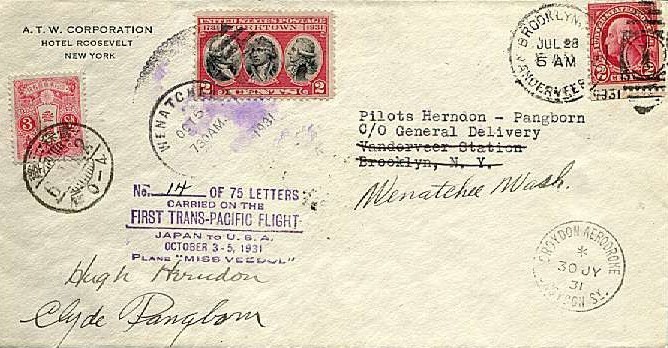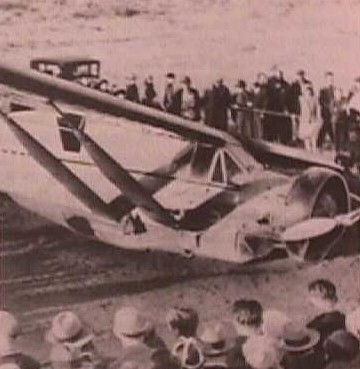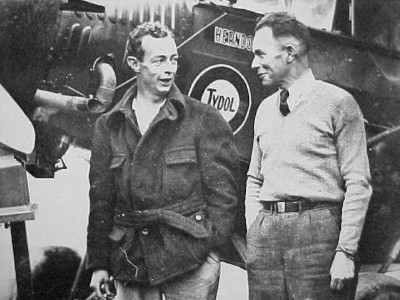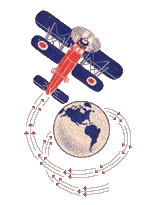Round-the-World Flights
Pangborn & Hendon Round-the-World Flight
Page 2e (rev: 1000)
| Flown Cover | Pangborn Autograph | Herndron Autograph | Wenatchee Belly Landing | Pangborn & Herndron |
|---|---|---|---|---|

|

|

|

|

|

Clyde Edward Pangborn & Hugh Herndon, Jr.
Clyde was born in Bridgeport, WA on October 28, 1896. He grew up in the
lumber camps of Idaho and graduated from St. Maries High School in 1914. He
continued his education with extension courses in civil engineering from the
University of Idaho. America's entry into the WW-I afforded him the
opportunity to fulfill his lifelong desire to learn to fly. He enlisted
in the Aviation Section of the Signal Corps and was trained as a pilot. After
his discharge he did exhibition flying for Northwest Aircraft Corporation in
Spokane, WA. While performing an "automobile-to-airplane" transfer at Coronado
Beach, CA he fell from the speeding car and was seriously injured.
In 1921, Pangborn joined Ivan R. Gates as a partner in the formation of
the Gates Flying Circus. For the next nine years, Pangborn "barnstormed"
across the entire US getting national recognition. The stock market crash of
1929 changed many things. Clyde teamed up with Hugh Herndon, Jr. forming "The
Flying Fleet" and began to tour the U.S., barnstorming and passenger
carrying but increased safety regulations and competition from the larger,
single-wing, closed-cabin aircraft spelled the end of the Pangborn-Herndon air
show. "The Flying Fleet" disbanded in February 1931.
Clyde and Hugh decided to break the round-the-world flight record of 20
days 4 hours set by the Graf Zepplin in 1929. They choose a Bellanca "J-300
Long Distance Special" (aka J-300 Special) as the perfect aircraft for
its range, lifting abilities and reliability. In July 1931 with their flight
preparations almost complete, their hopes for an round-the-world record
suffered a serious setback as Post and Gatty circumnavigated the globe in 8D
15H 15M. Pangborn reasoned that despite the Bellanca's slower airspeed, its
greater range and fewer refueling stops with rough-field take-off ability
would provide them the necessary advantage in breaking the Post-Gatty record.
On July 28, 1931 the heavily-laden "Miss Veedol" lumbered down New York's
Roosevelt Field and lifted off and headed out over the Atlantic on the first
leg of their round-the-world flight. They landed in Wales, and flew on to
London, Berlin and Moscow. Upon leaving Moscow for Siberia, they were almost
10 hours behind the time of Post and Gatty. Further difficulties plagued them
in Siberia. Herndon, at the controls while Pangborn slept, lost his way and
they finally landed in a village in Mongolia, Siberia. Back on course with
more hours lost, they flew to Khabarovsk, their last stop in Siberia. They
landed in Khabarovsk in a blinding rainstorm and settled deep into the mud of
the runway. They waited out the storm for a day putting them over 27 hours
behind Post-Gatty's time. This made them abandon their round-the-world speed
attempt.
They decided that they would try for the $25,000 prize offered by the
Japanese Asahi Shimbun Newspaper for the first nonstop flight from Japan to
the United States. They took off for Tokyo. Their flight path took them over
the northern Japanese island of Hokkaido and with the speed pressure off, they
felt like tourists and took photographs of the Japanese coastline. On landing
in Tokyo, they were arrested for having no papers and for photographing naval
installations. After considerable diplomatic wrangling they were fined for
their transgressions and released. After reluctantly giving the Americans
permission to attempt the Trans-Pacific flight, the Japanese officials
informed them that only one takeoff attempt was to be allowed. If the first
try failed, or the flyers were forced to return after takeoff, the Bellanca
would be impounded.
Two major obstacles faced the Americans if they were to successfully
complete the first non-stop Trans-Pacific flight. First, the Bellanca would be
overloaded with fuel and second, they might not have the range to complete the
flight if they encountered anything but perfect flying conditions. They
solved both by moving the plane approximately 200 miles north of Tokyo to the
8,000-foot runway at Sabishiro Beach and without the knowledge of the
Japanese, they designed a mechanism that would enable the flyers to drop the
Bellanca's landing gear once it was airborne. This would effectively increase
the airspeed by 15 mph or add approximately 600 miles to their range from the
expected 40 hour flight.
On October 4,1931 "Miss Veedol," burdened with 930 gallons of fuel and
weighing in excess of 9,000 pounds (far beyond the manufacturers' recommended
or even tested specifications) reluctantly took to the air and headed out over
the Pacific. Three hours into the flight, they jettisoned their landing gear
but the landing gear struts did not release. Pangborn crawled out onto the
wing supports and freed the two landing gear struts. His experience as a wing
walker in his early flying days had made the difference between a successful
flight and a crash-landing (a belly landing with the landing gear struts in
place could have proved fatal).
The two fliers coaxed the "Miss Veedol" toward the US mainland for a near
perfect belly-landing at Wenatchee, WA on October 5th, 1931. They made the
first non-stop Trans-Pacific flight in 41H 15M. Their feat exceeded that of
Lindbergh but strangely they received neither public acclaim nor financial
success. They won the Aviation League's Harmon Trophy symbolizing the
greatest achievement in flight in the year 1931.
After landing in Wenatchee, the "Miss Veedol" was trucked to Seattle
where the landing gear was rebuilt and refitted. Pangborn and Herndon then
flew on to New York to complete their round-the-world flight. They had not
established a new speed record, but they had been the first to cross the
Pacific non-stop.
Visit the Spirit of Wenatchee web-site for more information on this round-the-world flight.Visit the Khee-Kha Bush Plane Kit web-site for good & workable kits of the long-neglected workhorses from the "Golden Age of Aviation" (in collector's 1/72 scale).
